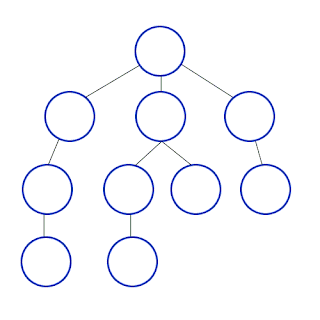Breadth First Search is a graph traversal technique that visits all vertices of the graph in a level order. By level, we mean that the source vertex is visited first, then all of its adjacent vertices, followed by vertices adjacent to those visited in the previous step. We use a queue for this purpose. To understand the traversal more clearly, we take an example of the below graph:
PROGRAM:
#include<stdio.h>
int a[20][20], q[20], visited[20], n, i, j, f = 0, r = -1;
void bfs(int v) {
for(i = 1; i <= n; i++)
if(a[v][i] && !visited[i])
q[++r] = i;
if(f <= r) {
visited[q[f]] = 1;
bfs(q[f++]);
}
}
void main() {
int v;
printf("\n Enter the number of vertices:");
scanf("%d", &n);
for(i=1; i <= n; i++) {
q[i] = 0;
visited[i] = 0;
}
printf("\n Enter graph data in matrix form:\n");
for(i=1; i<=n; i++) {
for(j=1;j<=n;j++) {
scanf("%d", &a[i][j]);
}
}
printf("\n Enter the starting vertex:");
scanf("%d", &v);
bfs(v);
printf("\n The node which are reachable are:\n");
for(i=1; i <= n; i++) {
if(visited[i])
printf("%d\t", i);
else {
printf("\n Bfs is not possible. Not all nodes are reachable");
break;
}
}
}
Output:
#include<stdio.h>
int a[20][20], q[20], visited[20], n, i, j, f = 0, r = -1;
void bfs(int v) {
for(i = 1; i <= n; i++)
if(a[v][i] && !visited[i])
q[++r] = i;
if(f <= r) {
visited[q[f]] = 1;
bfs(q[f++]);
}
}
void main() {
int v;
printf("\n Enter the number of vertices:");
scanf("%d", &n);
for(i=1; i <= n; i++) {
q[i] = 0;
visited[i] = 0;
}
printf("\n Enter graph data in matrix form:\n");
for(i=1; i<=n; i++) {
for(j=1;j<=n;j++) {
scanf("%d", &a[i][j]);
}
}
printf("\n Enter the starting vertex:");
scanf("%d", &v);
bfs(v);
printf("\n The node which are reachable are:\n");
for(i=1; i <= n; i++) {
if(visited[i])
printf("%d\t", i);
else {
printf("\n Bfs is not possible. Not all nodes are reachable");
break;
}
}
}
Output:

